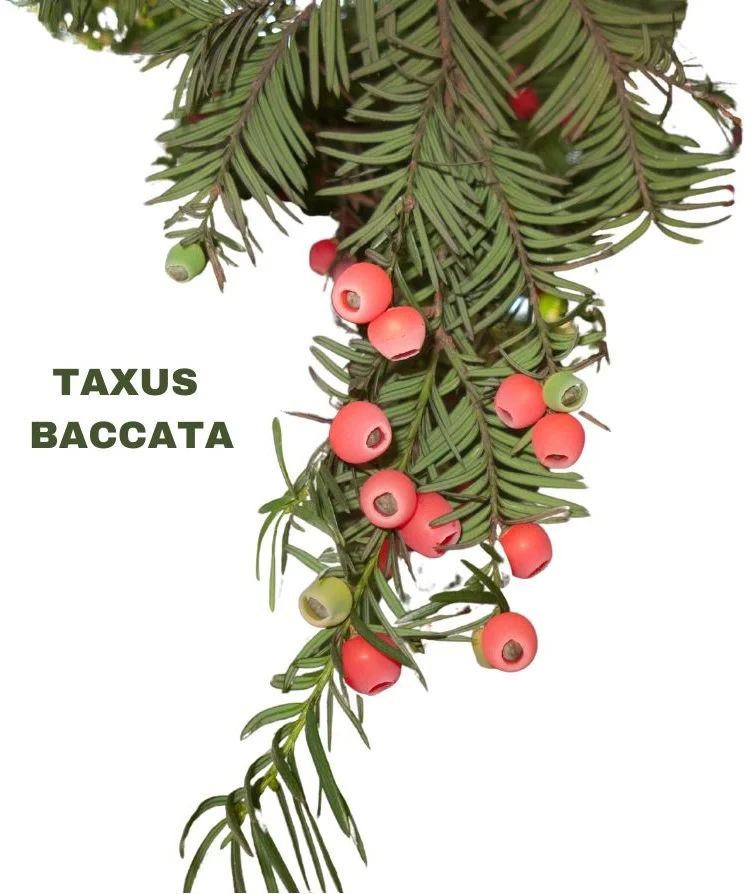Taxus Baccata, commonly known as Yew, is a remedy used in homeopathy for its effects on the skin, particularly in pustular skin conditions, and for its use in gout and chronic rheumatism.
It is also known for addressing night sweats and certain digestive and respiratory symptoms.

SOURCE INFORMATION
Scientific Classification
- Family: Taxaceae
- Common Name: Yew
- Found in: Europe, North Africa, and parts of Asia
- Active Components: Taxine alkaloids (which are toxic in large quantities)
Historical Facts
- The Yew tree has long been associated with both medicinal and toxic properties.
- Traditionally, parts of the tree were used in folk medicine to treat various ailments, but its potent toxicity also made it infamous as a poison.
DRUG PATHOGENESIS
- Taxus Baccata affects the skin, respiratory system, and digestive organs.
- It induces symptoms like pustular skin eruptions, nausea, acrid saliva, and a need to eat frequently due to a sensation of emptiness in the stomach.
- It is particularly useful in chronic conditions like gout and rheumatism.
KEY CHARACTERISTICS
- Pustular Skin Conditions: Large, flat, itching pustules on the skin.
- Night Sweats: Particularly unpleasant-smelling sweats occurring at night.
- Gout and Rheumatism: Effective in treating joint-related issues, especially chronic conditions.
- Head and Eye Pain: Right-sided supra-orbital and temporal pain, often accompanied by tearing (lachrymation).
DETAILED ORGAN SYMPTOMS
HEAD
- Pain around the right eye (supra-orbital region) and temple.
- Pupils may become dilated.
- The face may appear puffy and pale, indicative of weakness or systemic issues.
STOMACH
- Hot, acrid saliva that may cause discomfort in the mouth.
- Nausea and pain in the pit of the stomach and around the navel.
- A peculiar sensation of pins and needles in the stomach area, especially at the pit of the stomach.
- A feeling of emptiness in the stomach, leading to frequent eating.
SKIN
- Characterized by large, flat pustules that itch intensely.
- Night sweats, often with a foul odour.
- Gout symptoms, particularly podagra (gout affecting the big toe).
- Skin conditions like erysipelas (a bacterial infection of the skin) may also benefit from this remedy.
MODALITIES
- Worse: After eating, particularly with nausea and coughing.
- Better: Eating frequently helps alleviate the sensation of emptiness in the stomach.
WHAT ARE MODALITIES IN HOMOEOPATHY?
RELATIONSHIP WITH OTHER DRUGS
- Compare with: Other remedies from the conifer family (Coniferae), which share similar symptoms of frequent eating due to stomach discomfort.
DOSE
- Tincture to Third Potency: Commonly used in homeopathy in these forms.
Frequently Asked Questions
What conditions is Taxus Baccata used for?
- It is used for pustular skin diseases, night sweats, gout, and chronic rheumatism.
- It also addresses digestive issues such as nausea and acrid saliva.
Is Yew toxic?
- Yes, Taxus Baccata contains toxic compounds, especially in large doses.
- However, in homeopathic dilutions, it is considered safe and effective when used properly.
How does Taxus Baccata help with gout?
- It targets the inflammation and pain associated with gout, particularly in chronic cases, and helps alleviate joint pain and swelling.
Glossary
- Supra-orbital: Above the eye.
- Podagra: Gout, especially in the big toe.
- Lachrymation: Excessive tearing.
- Erysipelas: A bacterial infection causing red, swollen skin.
Taxus Baccata is a versatile remedy primarily used for skin issues, gout, and chronic rheumatic conditions, providing relief from symptoms like pustules, joint pain, and digestive discomfort.
